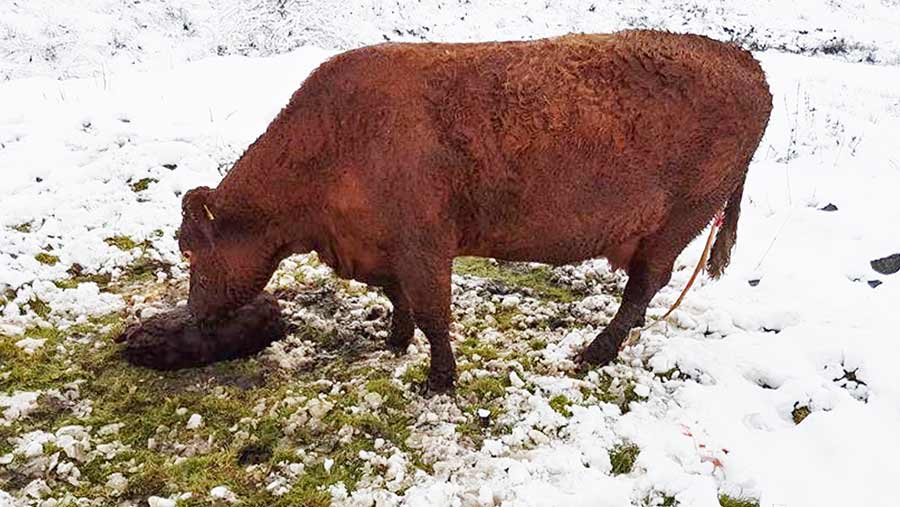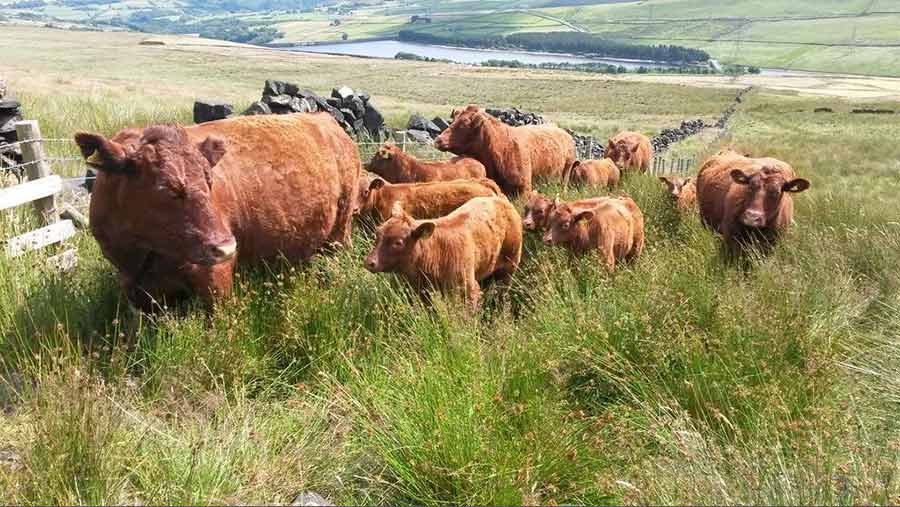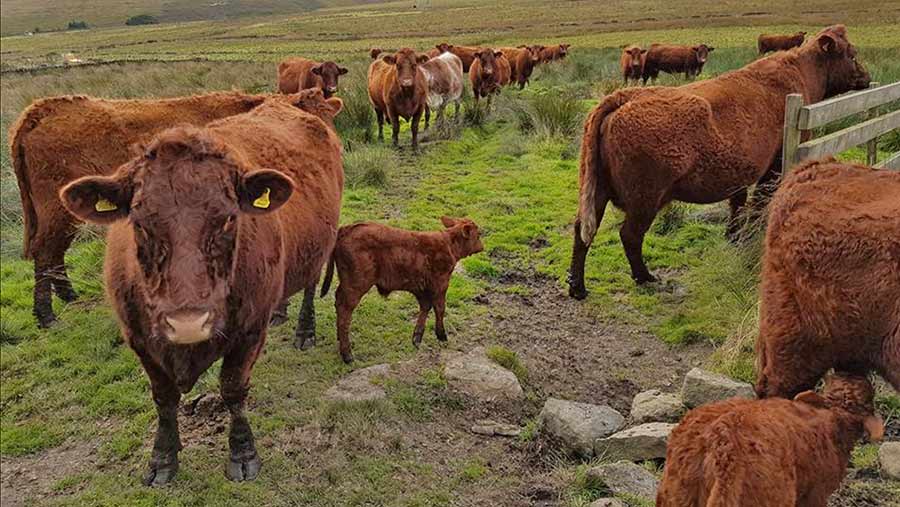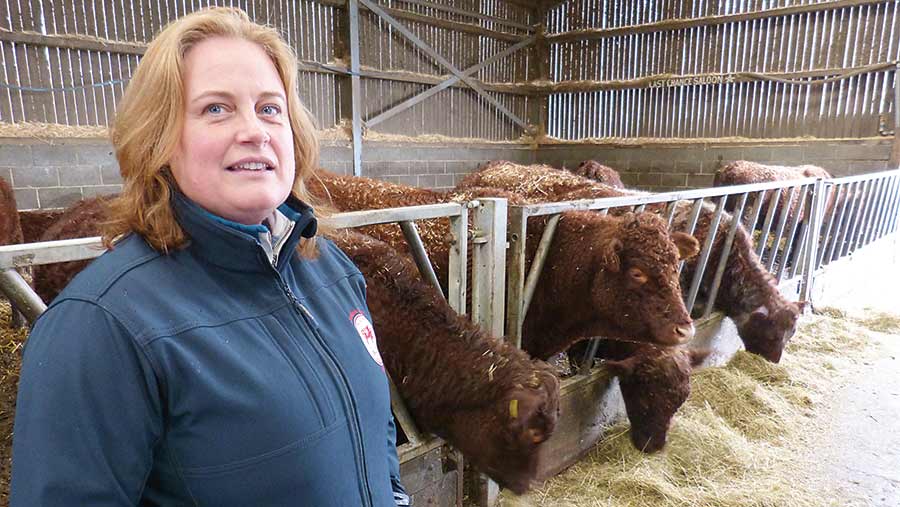How a Yorkshire suckler herd is achieving 96% calves weaned
 Cows calve outside unassisted in spring and autumn © Beeston Hall Salers
Cows calve outside unassisted in spring and autumn © Beeston Hall Salers An easy-calving herd is making light work of outdoor calving on a Pennine hill farm, with calf mortality at 1% in recent years and minimal assistance.
The Hallos family, from near Ripponden, West Yorkshire, have built up a herd of 80 pedigree Salers cows since going into suckler production in 2003.
In that time, they have calved their cows outdoors and assisted with just six calvings (0.51%) out of 1,164 in 15 years.
See also: Advice on feeding suckler cows at different stages of production
Easy-calving cows mean the Hallos family have live calves to sell, and they have also, somewhat unintentionally, found themselves benefitting from the ability to sell pedigree Salers due to the demand for easy-calving heifers for commercial herds using continental sires.
As for losses, this extends to one or two empty cows that get culled and perhaps one lost calf a year in recent years.
Beeston Hall Farm facts
- 809ha hill farm
- 40ha of cutting ground, of which 16ha is hay meadow
- 80 Salers cows and 300 Scottish Blackface ewes
- Shearlings bred to Lleyn, rest to Lonk
- Selling 30-35 pedigree bulling heifers each year
- 110ha of severely disadvantaged area (SDA) lowland ground
- All 590ha of fenced moorland is a Site of Special Scientific Interest (SSSI)
- Former producer/retailer dairy farm until 2002
- Store lambs and bulls sold at Skipton
- Biobest cattle health scheme, vaccinating and testing for BVD, Johne’s and IBR
Breeding
After successfully calving and breeding Salers-cross cattle out of the dairy herd as it was being dispersed, Beeston Hall Salers was built up by buying in pedigree cattle and grading up cross-bred cattle.
Breeding is generally done through natural service, with the farm requiring two bulls working across an autumn and a spring block of cows, which have been tightened to nine weeks since 2015.

Grazing is extensive and includes uplands rushes and heather moorland © Beeston Hall Salers
The spring block has become the elite herd and the autumn block is a more commercial herd, with the bottom 20 autumn cows being AI’d to a mix of continental sires, with Charolais and Simmental used this year.
Performance recording is not undertaken at Beeston Hall because of the extensive upland nature of the calving and concerns over the accuracy of collecting birthweights.

A spring-calving herd and an autumn-calving herd are run to help in the management of outlying moorland areas © Beeston Hall Salers
However, performance-recorded genetics are used, including cow lines from the Rigel herd of Terence and Jane Pye, Yarm, North Yorkshire, where bulls are selected on pelvic measurements to ensure ease of calving.
Other notable cow families include lines from the Cuil herd of the McClymonts, Newtown Stewart.
The autumn herd exists because of a need to run cattle over heather for environmental stewardship. Autumn-calving cows calve outdoors and calves are weaned at turnout and grazed extensively on a wild 590ha block of fenced heather moor.
Bulls are kept entire and sold as stores at Skipton Market, while heifers are either retained or sold at Welshpool or Castle Douglas, with 11-month-old heifers making £1,100 and 16-month-old heifers making about £1,500-£1,600.
Six tips on extensive calving
- Watch fields containing watercourses closely. It’s easy for newborn calves to drown.
- Whatever you do, start with easy-calving genetics.
- Field choice can matter. Plan for shelter for prevalent winds.
- Temperament is everything. It pays to have quiet cattle when you have to tag calves.
- When gathering and moving cattle, they won’t be pushed – they need to be tempted forward with feed.
- Good equipment is important. It takes effort to get creep up to remote locations so you want it staying dry and palatable. Trailer feeders must be good quality when accessing high areas on rough ground.
Calving
Stress is minimised in the run-up to calving for the spring calvers by maintaining a constant diet of silage/haylage and straw, with more straw being fed this year to make up for a 50% reduction in silage crop.
Winter feeding consists of trailer feeders leading haylage and/or straw to cows after grass growth stops.
Stephen Hallos and his son, Sam, walk through the cows each day when calving is due, turning out small numbers of cows that look likely to calve imminently. Once outside, they remain outside until November/December housing.
The farm works on an annual budget of 1,200 bales of haylage/year for cattle and sheep. Straw use is typically 110t/year across both enterprises.
The Hallos’ calving routine consists of casting an eye over cows due through the day and going into calving paddocks to tag calves and then record the gender and sire.
Calving needs to be simple, with 300 sheep to lamb from 16 April and a late-April calving, explains Rachel Hallos.
“The only issue might be having a calf born that falls into a watercourse,” says Mrs Hallos. “As an upland farm we have lots of rain and water channels.”

Rachel Hallos
Autumn calvers calve even more remotely, up on rushy in-bye fields, with the family taking their annual holiday in September, when autumn calving is in full swing.
The entire herd runs on a £21.46 a cow health budget for the year, including health scheme blood tests and membership, Biobest health scheme laboratory fees, vaccinations, a mineral bolus and clostridial injections for cows and calves.
Spring calvers |
Autumn calvers |
|
|
